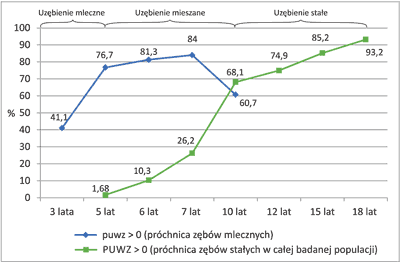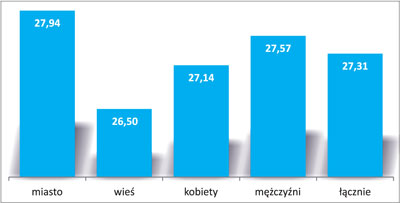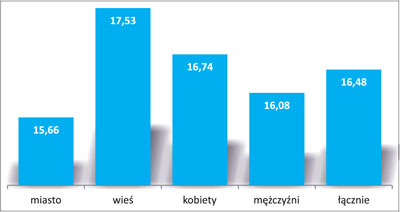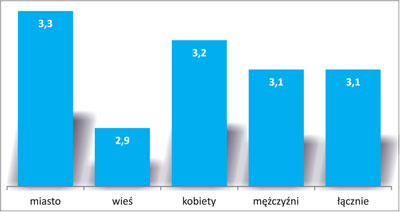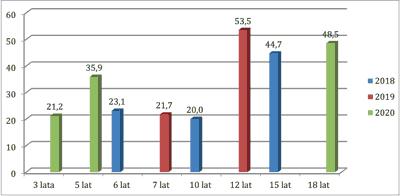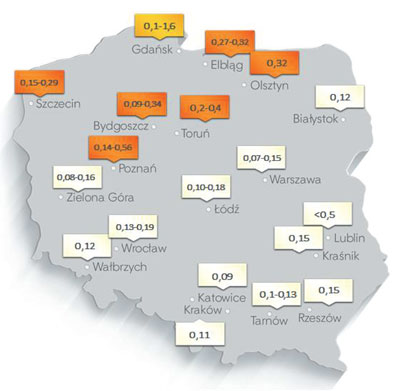Biorąc pod uwagę zarówno bezpieczeństwo, jak i skuteczność profilaktyki fluorkowej towarzystwa naukowe, w tym EAPD, AAPD, ADA i FDI, w oparciu o dowody naukowe opracowały zasady jej stosowania u dzieci (2, 3, 15-17). Przy opracowaniu rekomendacji brano pod uwagę:
– możliwe dzienne spożycie fluoru z uwzględnieniem fluoru pochodzącego z wody, żywności i środków profilaktycznych,
– odpowiednie spożycie dzienne fluoru (ang. adequate intake of fluoride – AI),
– dopuszczalny górny poziom spożycia fluoru u dzieci (ang. upper intake level of fluoride – UL) niepowodujący efektów ubocznych – fluorozy zębów (ang. no-observed-adverse-effect-level) (tab. 2).
Na podstawie zależności pomiędzy dawką spożywanego fluoru a występowaniem i nasileniem fluorozy zębów wykazano, że przy spożyciu 0,1 mg F/kg m.c./dzień średnio nasilona fluoroza zębów występuje u poniżej 5% populacji (72, 73).
Obecnie ogólnie przyjętymi zasadami stosowania związków fluoru w profilaktyce choroby próchnicowej jest unikanie nadmiernej endogennej ekspozycji na fluor oraz intensyfikacja działań zapobiegawczych w zależności od poziomu ryzyka próchnicy. Należy unikać nadmiernego (ponadoptymalnego) endogennego spożycia fluoru w okresie ryzyka rozwoju fluorozy zębów, zwłaszcza poniżej 6. roku życia poprzez:
– ograniczenie ilości pasty do zębów zawierającej 1000 ppm F (0,1%F) i stosowanie jej u dzieci do 8. roku życia pod kontrolą rodziców oraz stosowanie past z zawartością 5000 ppm F (0,5% F) po zleceniu przez lekarza dentystę powyżej 16. roku życia,
– wprowadzenie płynów do płukania jamy ustnej z fluorem, żeli i pianek fluorkowych dopiero po ukończeniu 6. roku życia (bez ograniczeń wiekowych mogą być stosowane lakiery fluorkowe),
– ograniczenie stosowania endogennych metod profilaktyki fluorkowej (15-17, 37, 74-76).
1. Pitts N, Melo P, Martignon S et al.: Caries risk assessment, diagnosis and synthesis in the context of a European Core Curriculum in Cariology. Eur J Dent Educ 2011; 15 Suppl 1: 23-31.
2. FDI World Dental Federation: FDI policy statement on promoting oral health through water fluoridation: revised version adopted by the FDI General Assembly: 13 September 2014, New Delhi, India. Int Dent J 2014; 64(6): 293-294.
3. Promoting oral health through fluoride toothpaste: Adopted by the FDI General Assembly: 7 September 2018, Buenos Aires, Argentina Original version adopted by the FDI General Assembly: November 2000, Paris, France. Int Dent J 2019; 69(1): 17-18.
4. O’Mullane DM, Baez RJ, Jones S et al.: Fluoride and Oral Health. Community Dent Health 2016; 33(2): 69-99.
5. Adamowicz-Klepalska B, Borysewicz-Lewicka M, Dobrzańska A et al.: Aktualny stan wiedzy na temat indywidualnej profilaktyki fluorkowej choroby próchnicowej u dzieci i młodzieży. Niezależny Panel Ekspertów. J Stoma 2013; 66(4): 428-453.
6. Olczak-Kowalczyk D, Borysewicz-Lewicka M, Adamowicz-Klepalska B et al.: Stanowisko polskich Ekspertów dotyczące indywidualnej profilaktyki fluorkowej choroby próchnicowej u dzieci i młodzieży. Nowa Stomatol 2016; 21(1): 47-73.
7. Kaczmarek U, Jackowska T, Mielnik-Błaszczak M et al.: Indywidualna profilaktyka fluorkowa u dzieci i młodzieży – rekomendacje polskich ekspertów. Nowa Stomatol 2019; 24(2): 70-85.
8. https://www.alliedmarketresearch.com/herbal-toothcare-market-A06037.
9. Rethman MP, Beltrán-Aguilar ED, Billings RJ et al.; American Dental Association Council on Scientific Affairs Expert Panel on Nonfluoride Caries-Preventive Agents: Nonfluoride caries-preventive agents: executive summary of evidence-based clinical recommendations. J Am Dent Assoc 2011; 142(9): 1065-1071.
10. Dorri M: Do xylitol?containing products help prevent dental caries in children? Cochrane. Collaboration 2016.
11. Riley P, Moore D, Ahmed F et al.: Xylitol-containing products for preventing dental caries in children and adults. Cochrane Database Syst Rev 2015; (3): CD010743.
12. Wolff MS, Schenkel AB: The Anticaries Efficacy of a 1.5% Arginine and Fluoride Toothpaste. Adv Dent Res 2018; 29(1): 93-97.
13. Olczak-Kowalczyk D, Turska-Szybka A, Woynarowska-Sołdan M et al.: Monitorowanie stanu zdrowia jamy ustnej populacji polskiej w latach 2016-2020. Wiedza i zachowania zdrowotne a próchnica zębów u dzieci i młodzieży w Polsce w latach 2016-2020. Edukacja prozdrowotna. Dział Redakcji i Wydawnictw Warszawskiego Uniwersytetu Medycznego 2019.
14. Kaczmarek U, Majewska L, Olczak-Kowalczyk D: Postawa i wiedza stomatologów w zakresie profilaktyki fluorkowej. Nowa Stomatol 2015; 20(1): 23-28.
15. AAPD: Fluoride Therapy. Aktualizacja 2018; https://www.aapd.org/globalassets/ media/policies_guidelines/bp_fluoridetherapy.pdf.
16. European Academy of Paediatric Dentistry: Guidelines on the use of fluoride in children: an EAPD policy document. Eur Arch Paediatr Dent 2009; 10(3): 129-135.
17. ADA Fluoridation Policy; https://www.ada.org/en/public-programs/advocating-forthe-public/fluoride-and-fluoridation/ada-fluoridation-policy.
18. Petersen PE, Ogawa H: Prevention of dental caries through the use of fluoride – the WHO approach. Community Dent Health 2016; 33(2): 66-68.
19. World Health Organization: WHO Expert Consultation on Public Health Intervention against Early Childhood Caries: report of a meeting, Bangkok, Thailand, 26-28 January 2016. Geneva. WHO/NMH/PND/17.1; 2017.
20. Phantumvanit P, Makino Y, Ogawa H et al.: WHO Global Consultation on Public Health Intervention against Early Childhood Caries. Community Dent Oral Epidemiol 2018; 46(3): 280-287.
21. Olczak-Kowalczyk D, Turska-Szybka A, Kaczmarek U et al.: Monitorowanie stanu zdrowia jamy ustnej populacji polskiej w latach 2016-2020. Ocena stanu zdrowia jamy ustnej i jego uwarunkowań w populacji polskiej w wieku 6, 10 i 15 lat w 2018 roku. Dział Redakcji i Wydawnictw Warszawskiego Uniwersytetu Medycznego 2019.
22. Olczak-Kowalczyk D, Mielczarek A, Kaczmarek U et al.: Monitorowanie stanu zdrowia jamy ustnej populacji polskiej w latach 2016-2020. Choroba próchnicowa i stan tkanek przyzębia populacji polskiej. Podsumowanie wyników badań z lat 2016-2019. Sekcja Druków Uczelnianych Warszawskiego Uniwersytetu Medycznego, Warszawa 2021.
23. Olczak-Kowalczyk D, Mielczarek A, Kaczmarek U et al.: Ocena stanu zdrowia jamy ustnej i jego uwarunkowań w populacji polskiej w wieku 3, 18 oraz 35-44 lata w 2017 roku. Dział Redakcji i Wydawnictw Warszawskiego Uniwersytetu Medycznego 2018.
24. Korporowicz E, Rożniatowski P, Sobiech P, Kochman K: Rodzaj i ilość past do zębów używanych przez rodziców u dzieci w wieku od 1 do 7 lat. Nowa Stomatol 2014; 3: 124-126.
25. Olczak-Kowalczyk D, Mielczarek A, Kaczmarek U et al.: Monitorowanie stanu zdrowia jamy ustnej populacji polskiej w latach 2016-2020. Ocena stanu zdrowia jamy ustnej i jego uwarunkowań w populacji polskiej w wieku 7, 12 i 65-74 lata w 2019 roku. Sekcja Druków Uczelnianych Warszawskiego Uniwersytetu Medycznego, Warszawa 2021.
26. Olczak-Kowalczyk D i wsp. Monitorowanie stanu zdrowia jamy ustnej populacji polskiej w latach 2016-2020. Stan zdrowia jamy ustnej dzieci w wieku 12 lat i młodzieży w wieku 18 lat w 2016 i 2019 roku. Sekcja Druków Uczelnianych Warszawskiego Uniwersytetu Medycznego, Warszawa 2021.
27. https://www.who.int/teams/environment-climate-change-and-health/water-sanitation-and-health/burden-of-disease/other-diseases-and-risks/fluorosis.
28. https://en.wikipedia.org/wiki/Fluoridation_by_countr; https://www.canada.ca/en/services/health/publications/healthy-living/community-water-fluoridation-across-canada-2017.html.
29. Borysewicz-Lewicka M, Opydo-Szymaczek J: Fluoride in Polish drinking water and the possible risk of dental fluorosis. Pol J Environ Stud 2016; 25(1): 9-15.
30. Olczak-Kowalczyk D, Turska-Szybka A, Gozdowski D, Kaczmarek U: Defekty rozwojowe szkliwa u młodzieży w wieku 18 lat w Polsce: rozpowszechnienie i wybrane czynniki socjodemograficzne. Badania przekrojowe. Nowa Stomatol 2018; 23(2): 47-54.
31. Jędra M, Sawilska-Rautenstrauch D, Gawarska H, Starski A: Zawartość fluoru w całodziennych racjach pokarmowych małych dzieci w Polsce. Roczn PZH 2011; 62(3): 275-281.
32. Featherstone JD: The caries balance: the basis for caries management by risk assessment. Oral Health Prev Dent 2004; 2 Suppl 1: 259-264.
33. Featherstone JD, Adair SM, Anderson MH et al.: Caries management by risk assessment: consensus statement, April 2002. J Calif Dent Assoc 2003; 31(3): 257-269.
34. AAPD: Guideline on Caries-risk Assessment and Management for Infants, Children, and Adolescents 2014. http://www.aapd.org/media/policies_guidelines/g_cariesriskassessment.pdf.
35. Beltrán EO, Guiu L, Zarta OL et al.: Caries classification and management in the context of the CariesCare International (CCI™) consensus: a clinical case study. Br Dent J 2019; 227(5): 363-366.
36. Pitts NB, Ismail AI, Martignon S et al.: ICCMSTM Guide for Practitioners and Educators. ICCMSTM Caries Manag 2014: 1-84.
37. Weyant RJ, Tracy SL, Anselmo TT et al.; American Dental Association Council on Scientific Affairs Expert Panel on Topical Fluoride Caries Preventive Agents: Topical fluoride for caries prevention: executive summary of the updated clinical recommendations and supporting systematic review. J Am Dent Assoc 2013; 144(11): 1279-1291. Erratum in: J Am Dent Assoc 2013; 144(12): 1335. Dosage error in article text.
38. Wright JT, Hanson N, Ristic H et al.: Fluoride toothpaste efficacy and safety in children younger than 6 years: a systematic review. J Am Dent Assoc 2014; 145(2): 182-189.
39. Moyer VA; US Preventive Services Task Force: Prevention of dental caries in children from birth through age 5 years: US Preventive Services Task Force recommendation statement. Pediatrics 2014; 133(6): 1102-1111.
40. Tubert-Jeannin S, Auclair C, Amsallem E et al.: Fluoride supplements (tablets, drops, lozenges or chewing gums) for preventing dental caries in children. Cochrane Database Syst Rev 2011; 2011(12): CD007592.
41. Walsh T, Worthington HV, Glenny AM et al.: Fluoride toothpastes of different concentrations for preventing dental caries. Cochrane Database Syst Rev 2019; 3(3): CD007868.
42. Wong MC, Clarkson J, Glenny AM et al.: Cochrane reviews on the benefits/risks of fluoride toothpastes. J Dent Res 2011; 90(5): 573-579.
43. Jullien S: Prophylaxis of caries with fluoride for children under five years. BMC Pediatr 2021; 21(Suppl 1): 351.
44. Li J, Dallas S, McBride-Henry K: Use of full strength fluoride toothpaste among preschoolers in New Zealand, and factors determining toothpaste choice. N Z Med J 2016; 129(1436): 44-51.
45. Nordström A, Birkhed D: Preventive effect of high-fluoride dentifrice (5,000 ppm) in caries-active adolescents: a 2-year clinical trial. Caries Res 2010; 44(3): 323-331.
46. Al-Mulla A, Karlsson L, Kharsa S et al.: Combination of high-fluoride toothpaste and no post-brushing water rinsing on enamel demineralization using an in-situ caries model with orthodontic bands. Acta Odontol Scand 2010; 68(6): 323-328.
47. Marinho VC, Chong LY, Worthington HV, Walsh T: Fluoride mouthrinses for preventing dental caries in children and adolescents. Cochrane Database Syst Rev 2016; 7(7): CD002284.
48. Marinho VCC: Cochrane fluoride reviews: an overview of the evidence on caries prevention with fluoride treatments. RCS 2014; 5(2): 78-83.
49. Alexander SA, Ripa LW: Effects of self-applied topical fluoride preparations in orthodontic patients. Angle Orthod 2000; 70(6): 424-430.
50. O’Reilly MM, Featherstone JD: Demineralization and remineralization around orthodontic appliances: an in vivo study. Am J Orthod Dentofacial Orthop 1987; 92(1): 33-40.
51. Twetman S, Keller MK: Fluoride Rinses, Gels and Foams: An Update of Controlled Clinical Trials. Caries Res 2016; 50 Suppl 1: 38-44.
52. Moberg Sköld U, Birkhed D, Borg E, Petersson LG: Approximal caries development in adolescents with low to moderate caries risk after different 3-year school-based supervised fluoride mouth rinsing programmes. Caries Res 2005; 39(6): 529-535.
53. Driscoll WS, Swango PA, Horowitz AM, Kingman A: Caries-preventive effects of daily and weekly fluoride mouthrinsing in a fluoridated community: final results after 30 months. J Am Dent Assoc 1982; 105(6): 1010-1013.
54. Heifetz SB, Meyers R, Kingman A: A comparison of the anticaries effectiveness of daily and weekly rinsing with sodium fluoride solutions: findings after two years. Pediatr Dent 1981; 3(1): 17-20.
55. Benson PE, Parkin N, Dyer F et al.: Fluorides for the prevention of early tooth decay (demineralised white lesions) during fixed brace treatment. Cochrane Database Syst Rev 2013; (12): CD003809. Update in: Cochrane Database Syst Rev 2019; 2019(11).
56. Marinho VC, Worthington HV, Walsh T, Chong LY: Fluoride gels for preventing dental caries in children and adolescents. Cochrane Database Syst Rev 2015; 2015(6): CD002280.
57. Marinho VC, Worthington HV, Walsh T, Clarkson JE: Fluoride varnishes for preventing dental caries in children and adolescents. Cochrane Database Syst Rev 2013; (7): CD002279.
58. Holve S: An observational study of the association of fluoride varnish applied during well child visits and the prevention of early childhood caries in American Indian children. Matern Child Health J 2008; 12 Suppl 1: 64-67.
59. Garcia RI, Gregorich SE, Ramos-Gomez F et al.: Absence of Fluoride Varnish-Related Adverse Events in Caries Prevention Trials in Young Children, United States. Prev Chronic Dis 2017; 14: E17.
60. Dikmen B: ICDAS II criteria (international caries detection and assessment system). J Istanb Univ Fac Dent 2015; 49(3): 63-72.
61. Kaczmarek U: Mechanizmy kariostatyczne fluoru. Czas Stomatol 2005; 6: 404-413.
62. Ogaard B: CaF2 formation: cariostatic properties and factors of enhancing the effect. Caries Res 2001; 35 Suppl 1: 40-44.
63. D’Hoore W, van Nieuwenhuysen JP: Benefits and risks of fluoride supplementation: caries prevention versus dental fluorosis. Eur J Pediatr 1992; 151(8): 613-616.
64. Dąbrowska E, Balunowska M, Letko E: Zagrożenia wynikające z nadmiernej podaży fluoru. Nowa Stomat 2001; 4(18): 22-27.
65. European Commision: Directorate-Deneral for Health & Consumers. Scientific Committee on Health and Environmental Risks SCHER: Critical review of any new evidence on the hazard profile, health effects, and human exposure to fluoride and the fluoridating agents of drinking water. SCHER 16.05.2011.
66. Public Health England: Water Fluoridation: Health monitoring report for England 2018; https://www.gov.uk/government/publications/water-fluoridation-health-mo-nitoring-report-for-england-2018.
67. Borysewicz-Lewicka M, Chłapowska J, Wagner L, Trykowski J: Ocena zawartości fluorków w niektórych krajowych wodach mineralnych. Czas Stom 1999; 52(1): 29-32.
68. Opydo-Szymaczek J: Znaczenie oceny ekspozycji na fluorki w profilaktyce stomatologicznej. Stomat Współczesna 2003; 5(10): 44-48.
69. Opydo-Szymaczek J: Fluoride Exposure from Diet in Infants and Young Children Fed with the Foodstuffs for Particular Nutritional Uses. Dent Med Probl 2012; 49(2): 209-215.
70. Borysewicz-Lewicka M, Opydo-Szymaczek J, Opydo J: Fluoride ingestion after brushing with a gel containing a high concentration of fluoride. Biol Trace Elem Res 2007; 120(1-3): 114-120.
71. Mejàre I: Current Guidance for Fluoride Intake: Is It Appropriate? Adv Dent Res 2018; 29(2): 167-176.
72. Dietary Reference intakes for Calcium, Phosphorus, Magnesium, Vitamin D, and Fluoride: Standing Committee on the Scientific Evaluation of Dietary Reference Intakes Food and Nutrition Board Institute of Medicine. National Academy Press, Washington, D.C. 1997: 288-313.
73. Opinion of the Scientific Panel on Dietetic Products, Nutrition and Allergies on a request from the Commission related to the Tolerable Upper Intake Level of Fluoride. The EFSA Journal 2005; 192: 1-65.
74. AAPD: Policy on Early Childhood Caries (ECC): Classifications, Consequences, and Preventive Strategies. 2014; http://www.aapd.org/media/policies_guidelines/p_eccclassifications.pdf.
75. Bhagavatula P, Levy SM, Broffitt B Et al.: Timing of fluoride intake and dental fluorosis on late-erupting permanent teeth. Community Dent Oral Epidemiol 2016; 44(1): 32-45.
76. Rozier RG, Adair S, Graham F et al.: Evidence-based clinical recommendations on the prescription of dietary fluoride supplements for caries prevention: a report of the American Dental Association Council on Scientific Affairs. J Am Dent Assoc 2010; 141(12): 1480-1489.
77. Beltrán-Aguilar ED, Barker LK, Canto MT et al.; Centers for Disease Control and Prevention (CDC): Surveillance for dental caries, dental sealants, tooth retention, edentulism, and enamel fluorosis – United States, 1988-1994 and 1999-2002. MMWR Surveill Summ 2005; 54(3): 1-43.
78. Wong MC, Glenny AM, Tsang BW et al.: Topical fluoride as a cause of dental fluorosis in children. Cochrane Database Syst Rev 2010; 2010(1): CD007693.
79. McPherson CA, Zhang G, Gilliam R et al.: An Evaluation of Neurotoxicity Following Fluoride Exposure from Gestational Through Adult Ages in Long-Evans Hooded Rats. Neurotox Res 2018; 34(4): 781-798.
80. FDI: Topical and Systemic Fluorides in Children with Renal Diseases. Aktualizacja 2009; https://www.fdiworlddental.org/resources/policy-statements-and-resolutions/topical-and-systemic-fluorides-in-children-with-renal.
81. Toumba KJ, Twetman S, Splieth C et al.: Guidelines on the use of fluoride for caries prevention in children: an updated EAPD policy document. Eur Arch Paediatr Dent 2019; 20(6): 507-516.
82. Steinbacher DM, Glick M: The dental patient with asthma. An update and oral health considerations. J Am Dent Assoc 2001; 132(9): 1229-1239.
83. IAPD Foundational Articles and Consensus Recommendations: Use of Fluoride for Caries Prevention: https://iapdworld.org/wp-content/uploads/2020/04/03_Use-of-Fluoride-for-Caries-Prevention.pdf, 2020.
84. American Dental Association Council on Scientific Affairs: Fluoride toothpaste use for young children. J Am Dent Assoc 2014; 145(2): 190-191. Erratum in: J Am Dent Assoc 2014; 145(3): 236.
85. https://www.fdiworlddental.org/sites/default/files/2020-11/2017-fdi_cpp-chairside_guide.pdf.
86. Fluoride: Topical and Systemic Supplements. 2021 https://www.ada.org/resources/research/science-and-research-institute/oral-health-topics/fluoride-topical-and-systemic-supplements.
87. Clark MB, Keels MA, Slayton RL; Section on oral health: Fluoride Use in Caries Prevention in the Primary Care Setting. Pediatrics 2020; 146(6): e2020034637.
88. Do LG; Australian Research Centre for Population Oral Health: Guidelines for use of fluorides in Australia: update 2019. Aust Dent J 2020; 65(1): 30-38.
89. New Zealand Guidelines Group: Guidelines for the use of fluorides. New Zealand Ministry of Health, Wellington 2009.
90. https://www.health.govt.nz/system/files/documents/publications/guidelines-for-the-use-of-fluoride-nov09.pdf.
91. https://www.nhs.uk/conditions/fluoride/.
92. Meyer-Lueckel H, Machiulskiene V, Giacaman RA: How to Intervene in the Root Caries Process? Systematic Review and Meta-Analyses. Caries Res 2019; 53(6): 599-608.
93. Zero DT, Fu J, Espeland MA, Featherstone JD: Comparison of fluoride concentrations in unstimulated whole saliva following the use of a fluoride dentifrice and a fluoride rinse. J Dent Res 1988; 67(10): 1257-1262.
94. Duckworth RM, Horay C, Huntington E, Mehta V: Effects of flossing and rinsing with a fluoridated mouthwash after brushing with a fluoridated toothpaste on salivary fluoride clearance. Caries Res 2009; 43(5): 387-390.
95. Whitford GM: The metabolism and toxicity of fluoride. Monogr Oral Sci 1989; 13: 1-160.
96. Pendrys DG, Haugejorden O, Bårdsen A et al.: The risk of enamel fluorosis and caries among Norwegian children: implications for Norway and the United States. J Am Dent Assoc 2010; 141(4): 401-414.
97. Milgrom P, Taves DM, Kim AS et al.: Pharmacokinetics of fluoride in toddlers after application of 5% sodium fluoride dental varnish. Pediatrics 2014; 134(3): e870-874.
98. Browne D, Whelton H, O’Mullane D: Fluoride metabolism and fluorosis. J Dent 2005; 33(3): 177-186.
99. Ekstrand J, Koch G, Lindgren LE, Petersson LG: Pharmacokinetics of fluoride gels in children and adults. Caries Res 1981; 15(3): 213-220.
100. Mascarenhas AK: Is fluoride varnish safe?: Validating the safety of fluoride varnish. J Am Dent Assoc 2021; 152(5): 364-368.
101. Public Health England: Delivering better oral health: an evidence-based toolkit for prevention about Public Health England. Gov.UK. 2017. Available from: https://www.gov.uk/government/publications/delivering-better-oral-health-an-evidence-based-toolkit-for-prevention.
102. SIGN 138 o Dental interventions to prevent caries in children A national clinical guideline March 2014 https://www.scottishdental.org/wp-content/uploads/2014/04/SIGN138.pdf.
103. Prevention and Management of Dental Caries in Children May 2018 (2nd Edition); https://www.sdcep.org.uk/media/2zbkrdkg/sdcep-prevention-and-management-of-dental-caries-in-children-2nd-edition.pdf.
104. Oliveira BH, Salazar M, Carvalho DM et al.: Biannual fluoride varnish applications and caries incidence in preschoolers: a 24-month follow-up randomized placebo-controlled clinical trial. Caries Res 2014; 48(3): 228-236.
105. Walczak M, Turska-Szybka A: The efficacy of fluoride varnishes containing different calcium phosphate compounds. Fluoride 2017; 50 (1 Pt 2): 151-160.
106. Turska-Szybka A, Gozdowski D, Twetman S, Olczak-Kowalczyk D: Clinical Effect of Two Fluoride Varnishes in Caries-Active Preschool Children: A Randomized Controlled Trial. Caries Res 2021; 55(2): 137-143.
107. Gugnani N, Pandit IK, Srivastava N et al.: International Caries Detection and Assessment System (ICDAS): A New Concept. Int J Clin Pediatr Dent 2011; 4(2): 93-100.
108. Chaffee BW, Cheng J, Featherstone JD: Non-operative anti-caries agents and dental caries increment among adults at high caries risk: a retrospective cohort study. BMC Oral Health 2015; 15(1): 111.
109. Fontana M: Enhancing Fluoride: Clinical Human Studies of Alternatives or Boosters for Caries Management. Caries Res 2016; 50 Suppl 1: 22-37.
110. Haugejorden O, Birkeland JM: Analysis of the ups and downs of caries experience among Norwegian children aged five years between 1997 and 2003. Acta Odontol Scand 2005; 63(2): 115-122.
111. Paris S, Banerjee A, Bottenberg P et al.: How to Intervene in the Caries Process in Older Adults: A Joint ORCA and EFCD Expert Delphi Consensus Statement. Caries Res 2020; 54(5-6): 1-7.
112. Güçlü ZA, Alaçam A, Coleman NJ: A 12-Week Assessment of the Treatment of White Spot Lesions with CPP-ACP Paste and/or Fluoride Varnish. Biomed Res Int 2016; 2016: 8357621.
113. Cochrane NJ, Cai F, Huq NL et al.: New approaches to enhanced remineralization of tooth enamel. J Dent Res 2010; 89(11): 1187-1197.
114. ten Cate JM, Cummins D: Fluoride toothpaste containing 1.5% arginine and insoluble calcium as a new standard of care in caries prevention. J Clin Dent 2013; 24(3): 79-87.
115. de Amorim RG, Leal SC, Bezerra AC et al.: Association of chlorhexidine and fluoride for plaque control and white spot lesion remineralization in primary dentition. Int J Paediatr Dent 2008; 18(6): 446-451.
116. Bergstrand F, Twetman S: A review on prevention and treatment of post-orthodontic white spot lesions – evidence-based methods and emerging technologies. Open Dent J 2011; 5: 158-162.
117. Zabokova-Bilbilova E, Popovska L, Kapusevska B, Stefanovska E: White spot lesions: prevention and management during the orthodontic treatment. Pril (Makedon Akad Nauk Umet Odd Med Nauki) 2014; 35(2): 161-168.
118. Wierichs RJ, Meyer-Lueckel H: Systematic review on noninvasive treatment of root caries lesions. J Dent Res 2015; 94(2): 261-271.
119. Park KJ, Meißner T, Günther E et al.: Arrest of root caries with an adjuvant chlorhexidine-fluoride varnish over a 12-months observation period: a QLF-analyzed, placebo-controlled, randomized, clinical trial (RCT). Odontology 2022; 110(1): 193-202.
120. Sleibi A, Tappuni AR, Baysan A: Reversal of Root Caries with Casein Phosphopeptide-Amorphous Calcium Phosphate and Fluoride Varnish in Xerostomia. Caries Res 2021; 55(5): 475-484.
121. Göstemeyer G, Schulze F, Paris S, Schwendicke F: Arrest of Root Carious Lesions via Sodium Fluoride, Chlorhexidine and Silver Diamine Fluoride In Vitro. Materials (Basel) 2017; 11(1): 9.
122. Khoroushi M, Kachuie M. Prevention and Treatment of White Spot Lesions in Orthodontic Patients. Contemp Clin Dent 2017; 8(1): 11-19.
123. Ganss C, Klimek J, Brune V, Schürmann A: Effects of two fluoridation measures on erosion progression in human enamel and dentine in situ. Caries Res 2004; 38(6): 561-566.
124. Ganss C, Hardt M, Lussi A et al.: Mechanism of action of tin-containing fluoride solutions as anti-erosive agents in dentine – an in vitro tin-uptake, tissue loss, and scanning electron microscopy study. Eur J Oral Sci 2010; 118(4): 376-384.
125. Lussi A, Carvalho TS: The future of fluorides and other protective agents in erosion prevention. Caries Res 2015; 49 Suppl 1: 18-29.
126. Carvalho TS, Colon P, Ganss C et al.: Consensus report of the European Federation of Conservative Dentistry: erosive tooth wear – diagnosis and management. Clin Oral Investig 2015; 19(7): 1557-1561.
127. Eversole SL, Saunders-Burkhardt K, Faller RV: Erosion protection comparison of stabilised SnF2, mixed fluoride active and SMFP/arginine-containing dentifrices. Int Dent J 2014; 64 Suppl 1: 22-28.
128. Faller RV, Eversole SL, Saunders-Burkhardt K: Protective benefits of a stabilised stannous-containing fluoride dentifrice against erosive acid damage. Int Dent J 2014; 64 Suppl 1: 29-34.
129. West NX, He T, Macdonald EL et al.: Erosion protection benefits of stabilized SnF2 dentifrice versus an arginine-sodium monofluorophosphate dentifrice: results from in vitro and in situ clinical studies. Clin Oral Investig 2017; 21(2): 533-540.
130. Lussi A, Buzalaf MAR, Duangthip D et al.: The use of fluoride for the prevention of dental erosion and erosive tooth wear in children and adolescents. Eur Arch Paediatr Dent 2019; 20(6): 517-527.
131. Kaidonis JA, Anastassiadis PM, Lekkas D et al.: Prevention and control of dental erosion by professionally applied treatment. Clin Dent Rev 2018; 2: 5.
132. Ganss C, von Hinckeldey J, Tolle A et al.: Efficacy of the stannous ion and a biopolymer in toothpastes on enamel erosion/abrasion. J Dent 2012; 40(12): 1036-1043.
133. Zhao IS, Yin IX, Mei ML et al.: Remineralising Dentine Caries Using Sodium Fluoride with Silver Nanoparticles: An In Vitro Study. Int J Nanomedicine 2020; 15: 2829-2839.
134. Duangthip D, Gao SS, Chen KJ et al.: Oral health-related quality of life of preschool children receiving silver diamine fluoride therapy: A prospective 6-month study. J Dent 2019; 81: 27-32.
135. Yu OY, Mei ML, Zhao IS et al.: Remineralisation of enamel with silver diamine fluoride and sodium fluoride. Dent Mater 2018; 34(12): e344-e352.
136. Zhao IS, Gao SS, Hiraishi N et al.: Mechanisms of silver diamine fluoride on arresting caries: a literature review. Int Dent J 2018; 68(2): 67-76.
137. Gao SS, Chen KJ, Duangthip D et al.: Preventing early childhood caries with silver diamine fluoride: study protocol for a randomised clinical trial. Trials 2020; 21(1): 140.
138. Duangthip D, Jiang M, Chu CH, Lo EC: Non-surgical treatment of dentin caries in preschool children – systematic review. BMC Oral Health 2015; 15: 44.
139. American Academy of Pediatric Dentistry: Policy on the use of silver diamine fluoride for pediatric dental patients. The Reference Manual of Pediatric Dentistry. Chicago, Ill.: American Academy of Pediatric Dentistry 2021: 68-71. https://www.aapd.org/media/Policies_Guidelines/P_SilverDiamine.pdf.
140. Grandjean ML, Maccarone NR, McKenna G et al.: Silver Diamine Fluoride (SDF) in the management of root caries in elders: a systematic review and meta-analysis. Swiss Dent J 2021; 131(5): 417-424. Epub 2021 Jan 29.
141. Yu OY, Zhao IS, Mei ML et al.: Caries-arresting effects of silver diamine fluoride and sodium fluoride on dentine caries lesions. J Dent 2018; 78: 65-71.
142. Tirupathi S, Svsg N, Rajasekhar S, Nuvvula S: Comparative cariostatic efficacy of a novel Nano-silver fluoride varnish with 38% silver diamine fluoride varnish a double-blind randomized clinical trial. J Clin Exp Dent 2019; 11(2): e105-e112.
143. Gao SS, Zhao IS, Duffin S et al.: Revitalising Silver Nitrate for Caries Management. Int J Environ Res Public Health 2018; 15(1): 80.
144. Yu OY, Zhao IS, Mei ML et al.: Effect of Silver Nitrate and Sodium Fluoride with Tri-Calcium Phosphate on Streptococcus mutans and Demineralised Dentine. Int J Mol Sci 2018; 19(5): 1288.
145. Gao SS, Chen KJ, Duangthip D et al.: Arresting early childhood caries using silver and fluoride products – A randomised trial. J Dent 2020; 103: 103522.

